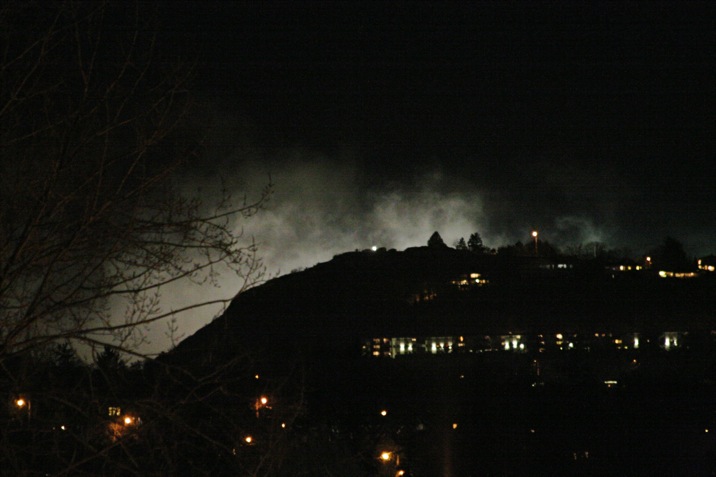
This is a well known landmark in Victoria, Mt. Tolmie, backlit with some mists over the University of Victoria in the background. Taken from my deck downtown, this is facing north-east.
300MM (480MM film equivalent), aperture: F5.6, shutter: 1/8, ISO3200. I think I shot this hand-held, but I can’t remember for sure. I have pretty steady hands, and Image Stabilization would have helped.
Say, I wonder how closely digital photography ISO increases came to conflicting with completely non-photography related international standards. Good old ISO12232:2006 would probably shed some light on that subject for those willing to pay 92 Swiss francs. I’ll leave that gem for a photography instructor.
For those not familiar with what camera ISO means, it’s a measure of sensitivity for the image sensor inside your camera. On film cameras, that would mean how fast the film inside will react (expose) to being hit by light, and on digital cameras, that means how much light is required to make an impression on the image sensor inside. The higher the ISO number, the more sensitive your film or image sensor is. Long story short, the darker it is, the higher ISO you’ll need.
Sounds simple enough. In practice, when you pump up the ISO from 50-100 (usually used in daylight) to 400-800, what you’re doing is telling the image sensor to collect more data than usual. This means that, in addition to getting your relatively faint subject, your camera will also be collecting useless data, which is referred to as (film) grain or visual noise. This is the trade-off of increased sensitivity – you get a bit more of everything, even stuff you don’t want.
Personally I don’t mind some grain in a photo – it shows a bit of the determination required to get the photo in the given environment. Some of the advances in the newer digital SLRs are in regard to image sensor ISO capabilities, with the new Canons and Nikons going up to ISO25600 and beyond. I would imagine this level of ISO to be extremely grainy or noisy, and henceforth require some serious noise reduction. DPReview has a simple visual to help illustrate what is meant by noise.
This is pretty cool technology as it allows you to take photos in relatively low light. Before companies were competing on camera ISO – when ISO capabilities found themselves in stasis – you would have to lower your aperture to take low-light photos. It might not sound like a big deal, but when you depend on lens construction for lower light capabilities, you are bound by focal length and the sheer expense of low aperture glass. With aperture, the lower you go (measured in “F” stops), the more light can get into the camera and hit the sensor or film. For Canon, a 50MM F1.8 lens could cost around $70-$200; a 50MM F1.4 lens will likely cost between $300-$600; a 50MM F1.2 lens will cost even more, around $1500. As you can see, going down by small amounts of aperture costs a lot and is restricted to the lens that is on the front of your camera. Since ISO settings are a part of the camera and not the lens, those with dSLRs may switch lenses and retain the benefit of higher ISO capabilities.
In conclusion, ISO is important if you feel like shooting at night without a tripod. If you feel like lugging a tripod around with you at all times, then this will be less relevant to you. Of all the technologies that are being pushed on higher end consumer dSLRs, this is one the items that excites me the most as it makes less expensive equipment more effective and valuable.
Ok, back to sleep. Yes, I really did wake up at 4:30 AM and write for an hour straight on ISO.
25600??!? Holy crunch!
I wonder if other photographers went through the same phases I went through; the phases of what I believed to be important in photography.
Digitally, it started with megapixels. Then, it was the processor. After that, the wideyness and zoominess, the sharpiness and the DOF-iness. Now, I’m all about speed and low-light lenses or, at least, researching how I’ll be all about speed and low-light lenses when I sell another kidney on eBay.
my p00r lil Kodak p712 only has ISO400 so I am still waaaaaay back on the road towards having a complex camera. I really dont think I want a DSLR but Nikon sure has a lovely point’n’click that does most of what I want a camera for. There are other priorities at the moment though, like teeth to bite with, before cameras are even considered.